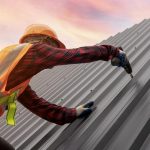Modern structures need minimum insulation, but older ones require proper insulation in walls and attic as they are under-insulated. Blown-in insulation is made of tiny particles that are sprayed into walls and attics through a long pipe. During the building process, batt insulation, solid bands of fiberglass or cellulose, is installed in wall studs and ceiling beams before placing the wallboard to increase the insulation effect. To install batt, one needs to tear down a wall which is a costly, muddled, and time-consuming process. To most homeowners, it is not practical.
Moreover, blown insulation closes air pockets, small fissure, and crack as it inhabits. This sort of insulation not only insulates the home but acts as a sound barrier reducing transmitting of sound from outside or inside.
The process
If you want to install blown-in insulation in present walls, holes are made at the top of each brick on the external side, and the insulation substance is blustered through a long supply pipe. Then the openings are covered with corresponding plugs and colored accordingly to match the texture. But if the exterior is made of stone or brick, the openings are noticeable even after sealing. A drain pipe embedded into a wall or outlet box can obstruct the blow in the insulation process, keeping the space void of insulation. After a few years, blown-in insulation tends to squeeze a bit (a few inches), decreasing the overall thermal resistance (denoted as R-value) as the upper most portion of the wall becomes uninsulated. Reinforcing the insulation on the part is an option, but most homeowners ignore it.
R2.5 thermal value
Mostly lose, filled fiber glass, cellulose, and rock wool are used for blown-in insulation. Each has its pros and cons. The recommended insulation values differ according to geographic location. You can find the suggested value of your residence in the Energy Star Map. Material with a higher R-value has more effectual insulation consequences. Lose-filled fiber glass blown-in insulation comes with a standard R2.5 thermal value per inch. For a batt value of R19 insulation (the typical barometer), 7.5 inches of fiberglass blow-in insulation is required.
Cellulose insulation R3.7
Homeowners who are eco-friendly opt for cellulose insulation as they are made from recycled newspapers or cardboard. They are chemically treated to make them fire and mold resistant. The average R-value of cellulose insulation is R3.7 for R19 batt insulation; five inches of cellulose insulation is required. The disadvantage of cellulose insulation is it gets squelchy and contracted when it comes in contact with water from leakage and loses its efficacy. Rock wool or mineral wool insulation is made from blast furnace slag with an average R-value of 3.3 per inch.
Reasons to remove
Mold spots, holes, uneven indoor temperature, and dropping of pests are prime reasons to remove blown insulation. If there are visible cracks in the insulation, it is a clear sign the insulation needs to be reinstated. If you observe black, brown, or grey mold spores on the insulation, it is time to remove and replace it. The overall shade of the insulation indicates its present condition. If it turns wishy-washy and dusty, it is time to replace it.










